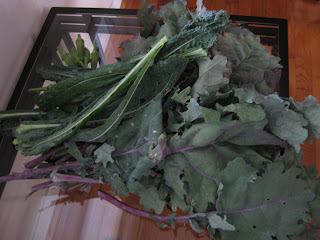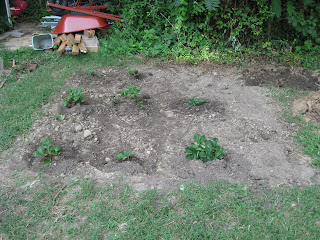We've got a major change coming to the garden soon, so I thought that this would be a good time for an update. The garden is transitioning from summer to winter well, and as the summer plants die off and produce less and less, the winter crops that have been plagued by bugs and excessive heat all year are healthier and leafier than ever. It's hard to watch the mainstays go- particularly the okra and tomatoes- but it's also good to see the plants for the next season develop. We've prepared for winter, though, and mulched the beds and set up stakes so that we can extend the life of the annuals by protecting them from minor frosts with sheets of fabric and plastic.We've been in touch with groups and individuals on campus for selling our produce, and soon we'll have a final harvest of summer plants that we'll sell to those groups and on the plaza.
The anticipated selection of crops for the winter is: Kale, Collard Greens, Broccoli, Brussels Sprouts, Leeks, and Swiss Chard.
The major plans for the cold season are already at our front door. We've ordered 44 fruit trees and berry bushes that are coming in time for a volunteer workday on Sunday. We'll try to get them all in the ground, but may also have to dig a trench to place them in if we can't finish by the end of the work day. Essentially, we can dig a trench deep enough for the plants, place them at an angle within it, cover them with soil and water them regularly, and they should be ok until we are ready to plant them.
The trees and bushes we are planting are:
| 4 Improved Kieffer Pear Tree 4-5' 2 Fuji Apple Tree 3-4' 2 Braeburn Apple Tree 3-4' 2Tanenashi Persimmon Tree 1-2' 4 Italian Everbearing Fig Tree 2-2.5' | |
| 1 Eastern Seedling PawPaw Tree 4-5' 1 Collins Select PawPaw Tree 4-5' 8 Tifblue Blueberry Plant 1-2' 8 Briteblue Blueberry Plant 1-2' 4 Brightwell Blueberry Plant 2-3' 4 Austin Blueberry Plant 2-3' 2 Golden African Banana Plant Mother Bulb 2 American Elderberry 4-5' We are, needless to say, very excited about these new additions! Their addition will be the first of a long series of winter projects including landscaping, working on the terrace, managing seedlings, and building a perennials bed. |















